Say Goodbye to Italy in Style: A Perfect Finale at Ostia Antica
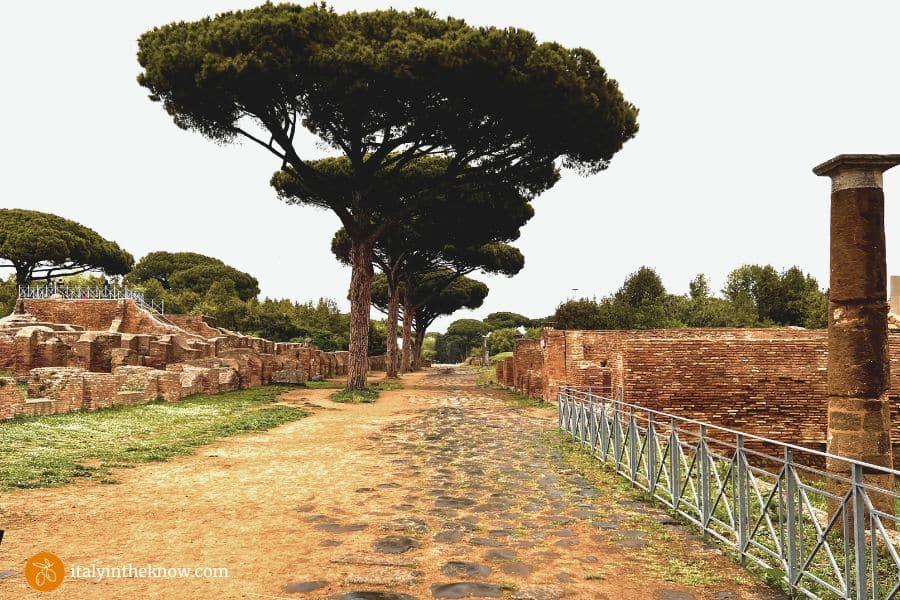
Looking for a great way to end your trip to Italy? You’ve come to the right place, especially if you’re departing from Rome. The answer is spending an idyllic day in Ostia Antica.
This is the perfect way to transition, say goodbye to Italy, and prepare for return travel. In fact, the location makes departure from Fiumicino Airport incredibly easy. If you’re flying out of Rome, consider adding a visit to Ostia Antica at the end of this 10-day itinerary to Rome, Florence, and Venice.
While most people know of Pompeii, Ostia Antica is still rather unfamiliar. However, like Pompeii, it is a city that was covered, preserved and forgotten for centuries.
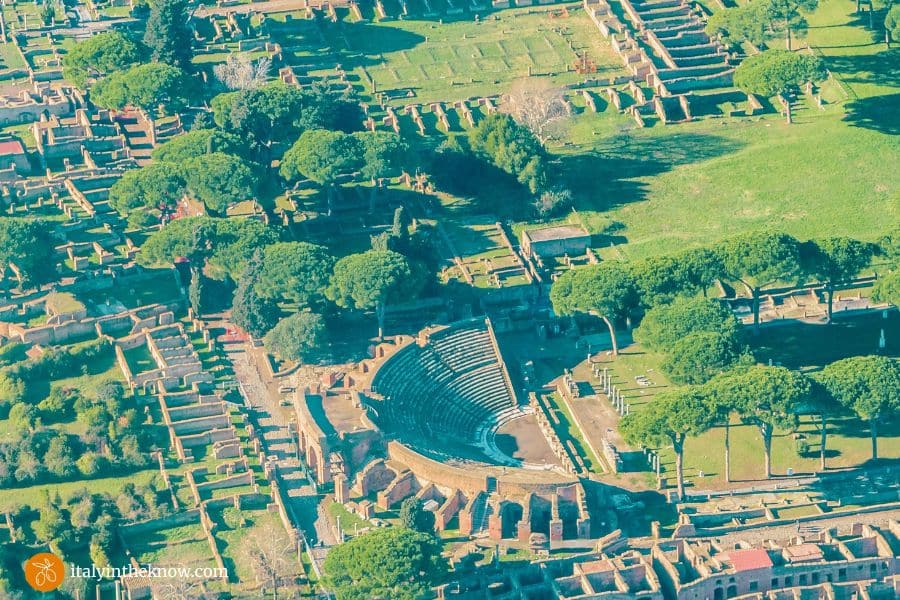
Instead of a volcano, Ostia Antica was buried with sediment from a massive flood. In the late 19th century, excavations began to uncover the magnificent wonders preserved by mud and silt.
Today you can wander throughout the ruins of the city. Also, because it is not a well- known tourist destination, the city is wonderfully uncrowded.
If I’m flying out of Rome, I stay in Ostia Antica for my last two nights. It is always a special experience that never gets old. Each visit, I discover new and unexpected delights as I wander through the archeological site.
Here you’ll find a complete plan so you can have this special experience too. Use this table of contents to easily navigate within the post:
- Exploring the Archeological Area, including must-see sites
- Other Sites to See in Ostia Antica
- Getting There
- Leaving
- Where to Stay
- Where to Eat
Exploring the Archeological Area of Ostia Antica
A brief history
Ostia Antica is filled with history…and it is ancient dating back to 620 BC. The site that became Ostia Antica was in a strategic location. On one side it bordered the Mediterranean Sea and on another the Tiber River.
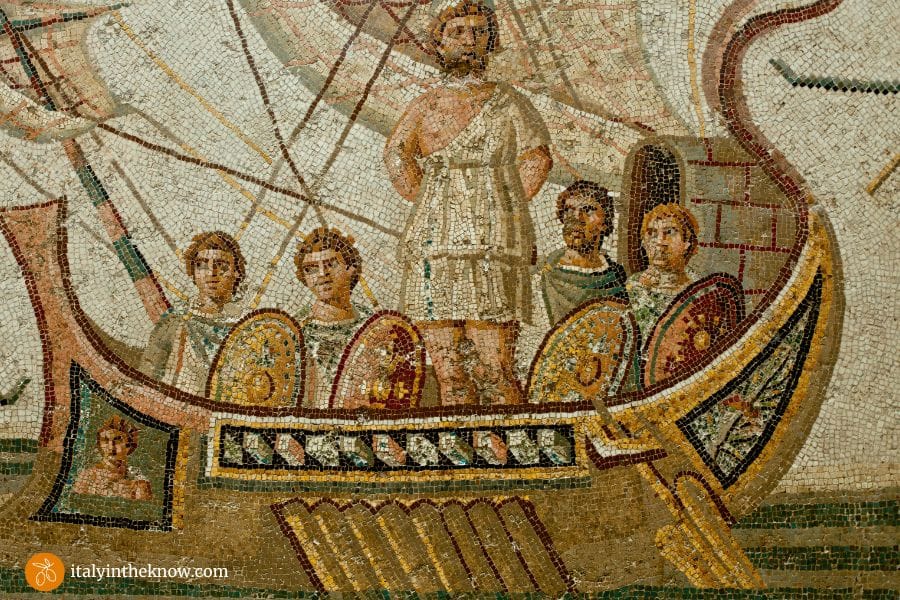
In ancient times, transportation was mainly by water. So, whoever controlled the waterways had power.
Also, one of the ancient world’s most valuable resources was nearby – salt. This was harvested from the marshes at the mouth of the Tiber River.
Around 300 BC the Romans built a military fortress called the Castrum. It became the first official Roman Colony.
Over time the population grew, and the colony transitioned to more commercial activities. With this change, the town became known as Ostia.
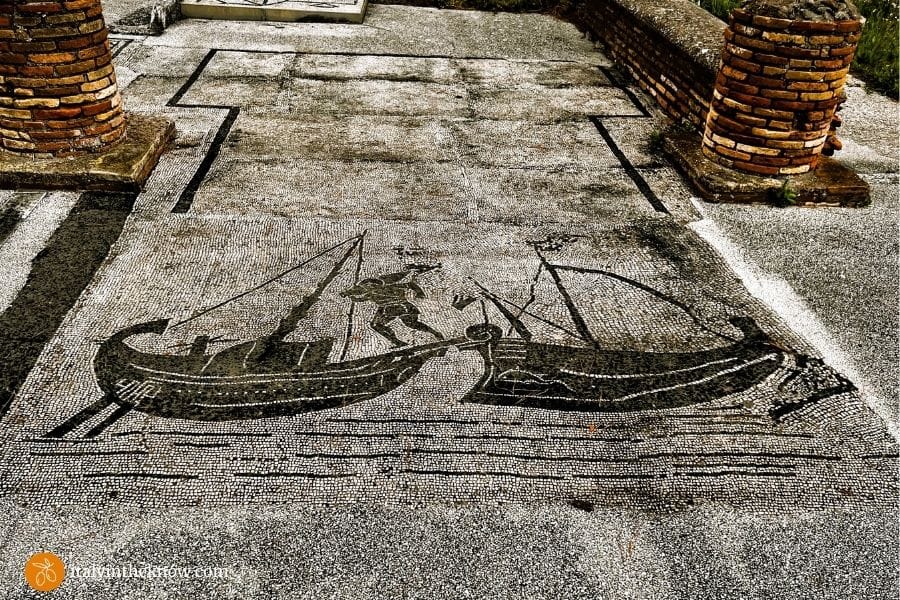
Ostia played a central role as the key port that supplied grain to Rome. Cargo ships came into the harbor and their freight had to be transferred to smaller river boats and barges. Then, these vessels travelled the Tiber River to Rome.
In its heyday, Ostia was a thriving cosmopolitan city with a population nearing 50,000.
Because it has been preserved, visitors today get a unique glimpse into life in ancient Rome. When you pass through the necropolis outside the Porta Romana, you step back to an earlier time.
New discoveries lie around every corner, especially if you wander away from the main road, the Decumanus Maximus. For the most part, you have access to everything and can roam at will.
Basics
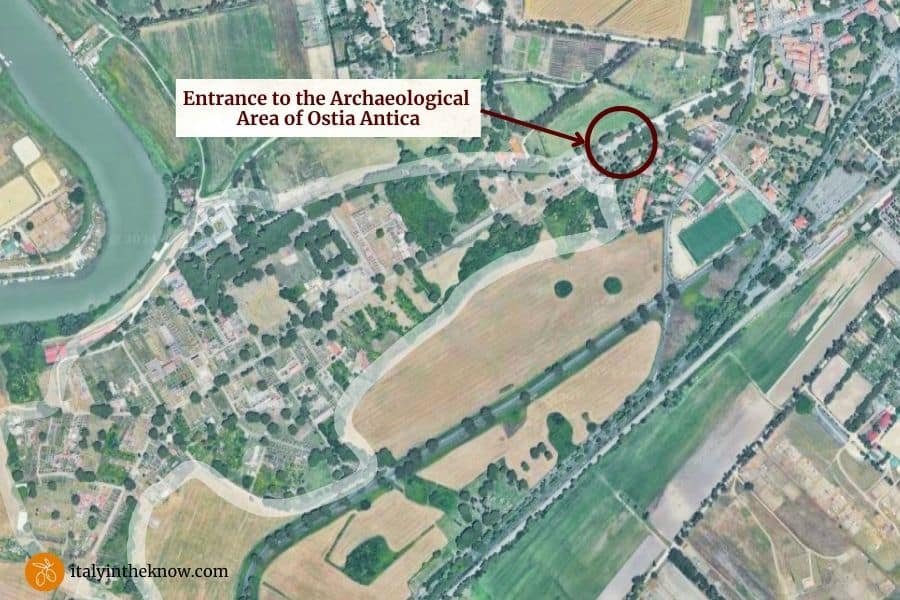
The ancient city of Ostia is known today as Ostia Antica. This is important because there is another present-day town of Ostia. Today’s Ostia is found southwest of Ostia Antica along the current coast of the Mediterranean Sea.
Over the centuries, both the Tiber River and Mediterranean Sea shifted positions. So, make sure you use “Ostia Antica” when talking about your destination so that you don’t end up in a different place.
The entrance to the archeological site is at the Porta Romana, one of the city’s three gates. Here is where you buy your tickets. You can also purchase tickets online but there is no need to do so.
Check the official website for hours and prices. Ostia Antica is closed on Mondays. So, plan your visit accordingly.
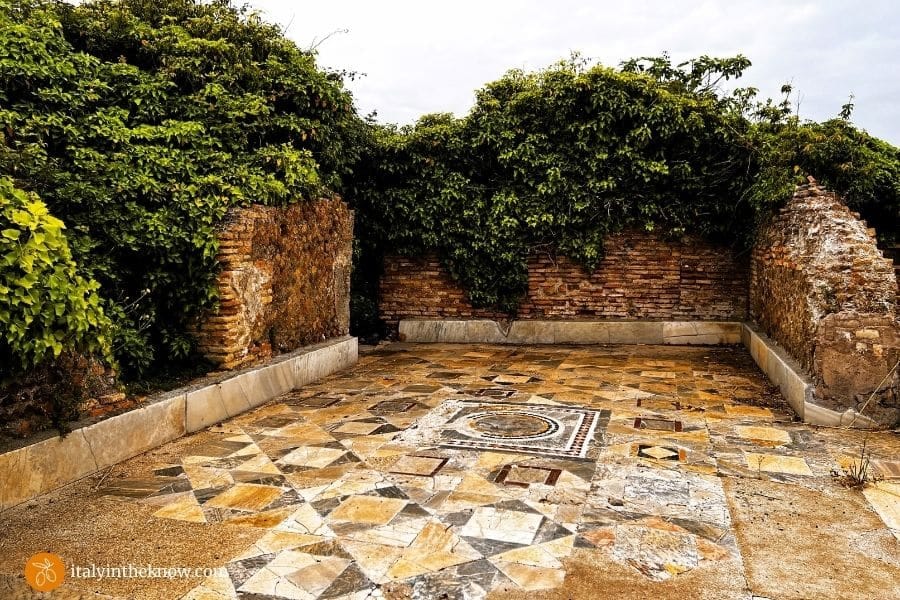
Ostia Antica was an ancient city, and it covers a lot of ground. The main road through the city is over 5.5 miles long with about half a mile on either side.
Touring the Area
Guided tours are available; however, I highly recommend renting one of the audio tours at the ticket office when you enter. It comes with a map of the key sites for each tour.
These sites are labeled with a number throughout the archeological area. When you come to a number, you enter it and hear about the site.
I enjoy this self-guided approach because you can pick and choose to see the sites that interest you. You can also set your own pace.
If you see everything, the short tour has 26 stops taking 3 hours. The long tour includes information on 60 sites and takes 7 hours.
Don’t let this overwhelm you! You can pick and choose what you locate and listen to. There is also an audio guide version for kids.
For lunch or other breaks, a cafeteria on the grounds offers a nice variety of hot and cold foods. If you want a souvenir, there is a good book/gift store next to the cafeteria with a wide assortment of items for sale.
Highlights
Here are highlights to see during your visit:
Necropolis

After the ticket office, you’ll pass through the necropolis as you move toward the city gates. In ancient Rome, no burials were allowed within a city. So, a necropolis (city of the dead) was often placed right outside the city gates.
You can easily tell the difference between pagan and Christian burials. Pagans cremated their dead while Christians placed the dead in sarcophagi.
Baths
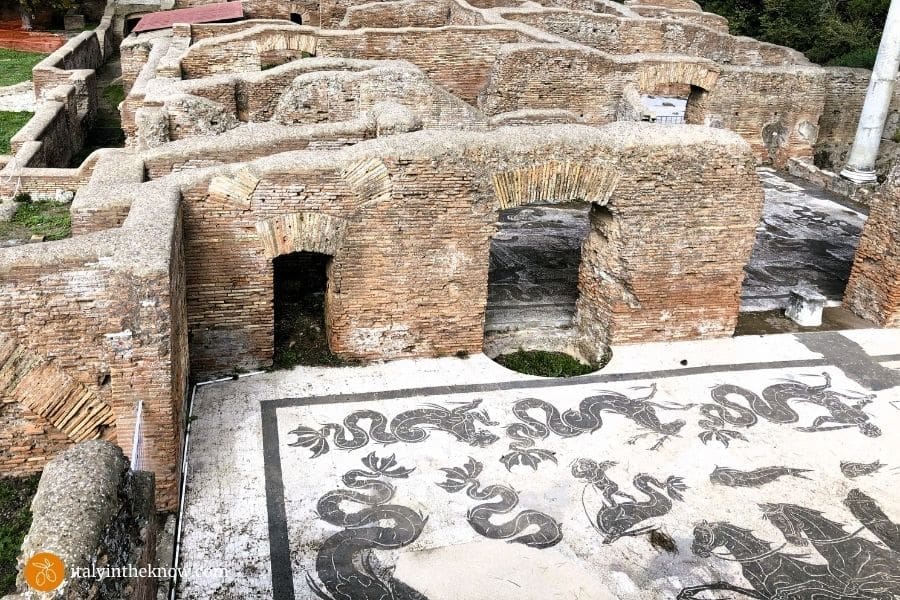
There are many baths within the city, and you want to check out at least one. Bathing was a public activity in ancient Rome and afternoons were the time to be there.
There were elaborate with mosaics and marble throughout. You’ll see:
- Entry Halls
- Apodyterium (changing rooms)
- Frigidariums (cold bath rooms)
- Tepidariums (warm bath rooms)
- Caldariums (hot bath rooms)
- Laconicum (steam rooms)
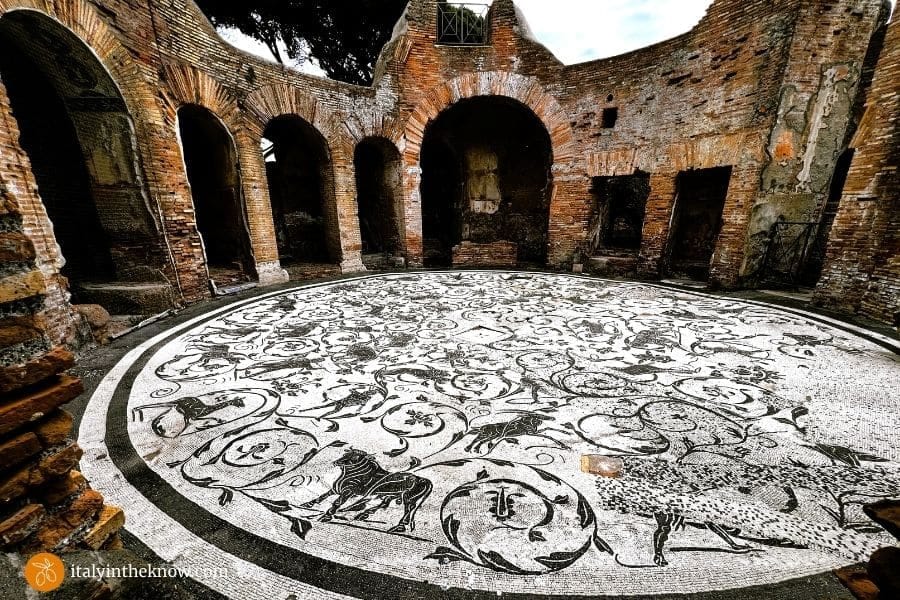
Look for openings near the base of the walls. These were outlets from pipes to the crawl spaces. There, crouching slaves kept fires burning to maintain correct temperatures.
Some baths will also have gymnasiums and even a helio caminus that was used for sunbathing.
Nearby there is often a forica (VERY public latrine). Only the rich could afford private bathrooms at home.
Theater
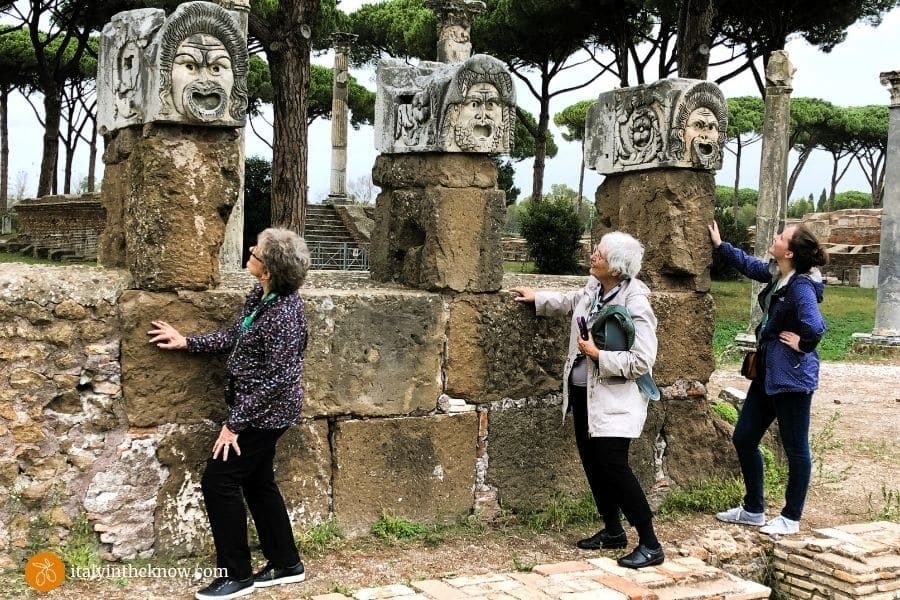
The theater in Ostia Antica holds up to 4,000 people and is still used for events today. It is one of the most ancient buildings constructed in masonry.
Look for the arches within the walls. Roman engineers used interior and exterior arches for strength and stability.
The theater played a key role in the social life of the city. It hosted many events, even aquatic shows in which the orchestra section was flooded.
Sadly, it was also the site where many Christians were martyred.
Climbing to the top you get a great view of the surrounding area.
Piazzale delle Corporazioni
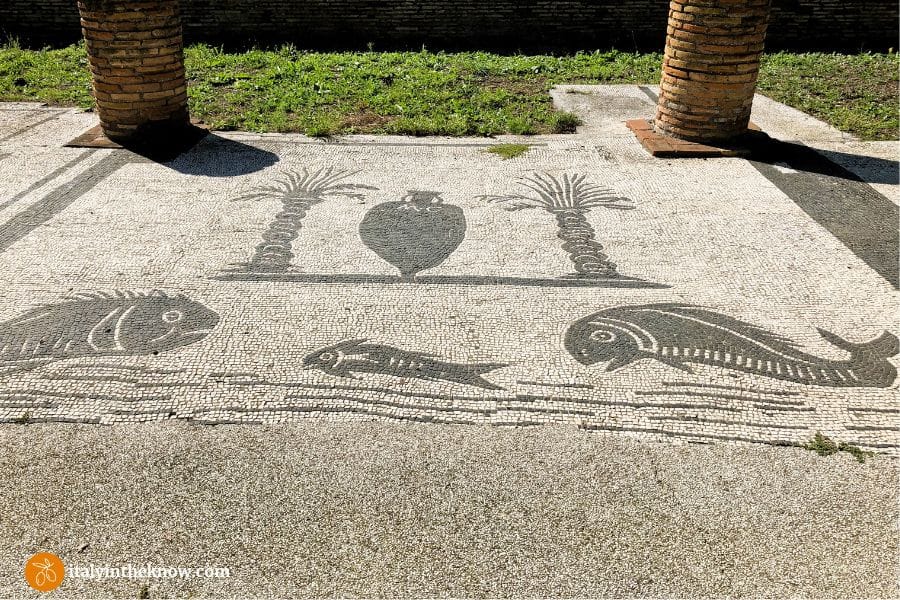
Piazzale delle Corporazioni, roughly translates to the plaza of the corporations. It is a unique area not found in any other Roman city.
This was the center of economic and commercial activity in Ostia. It borders the theater with its remaining three sides divided into office spaces.
These were the offices of corporations operating throughout the Mediterranean. Floor mosaics showed the business at that each location.
Forum
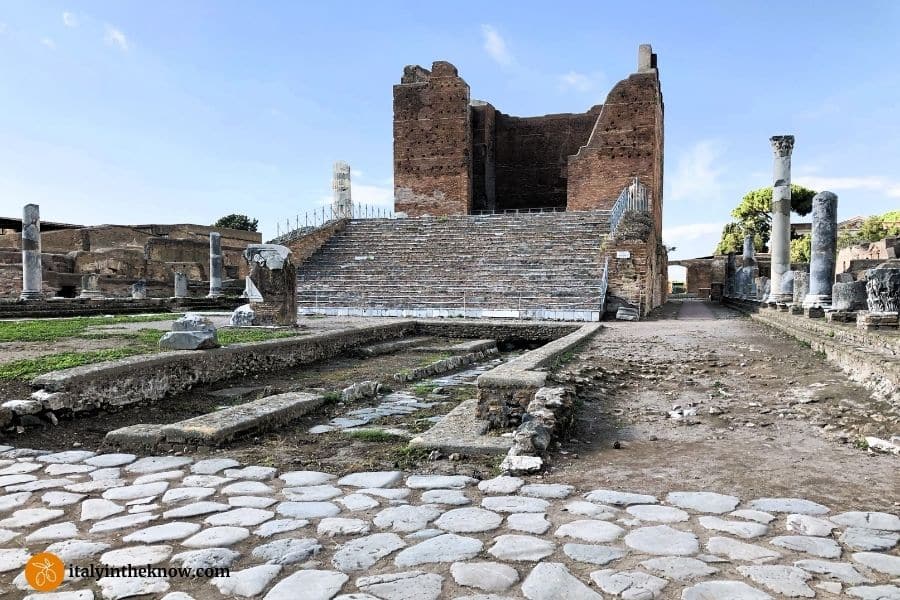
Ostia’s Forum was located at the intersection of its two main roads – the Decumanus and Cardo. The forum was the key square in a Roman city and the center of civic and political life.
On the north side is the Capitolium, the principle sacred building in the city. It was dedicated to the Capitoline triad of gods: Jupiter, Juno, and Minerva.
You can still see remnants of the porticoed columns of the forum on both sides of the Capitolium.
Laundry
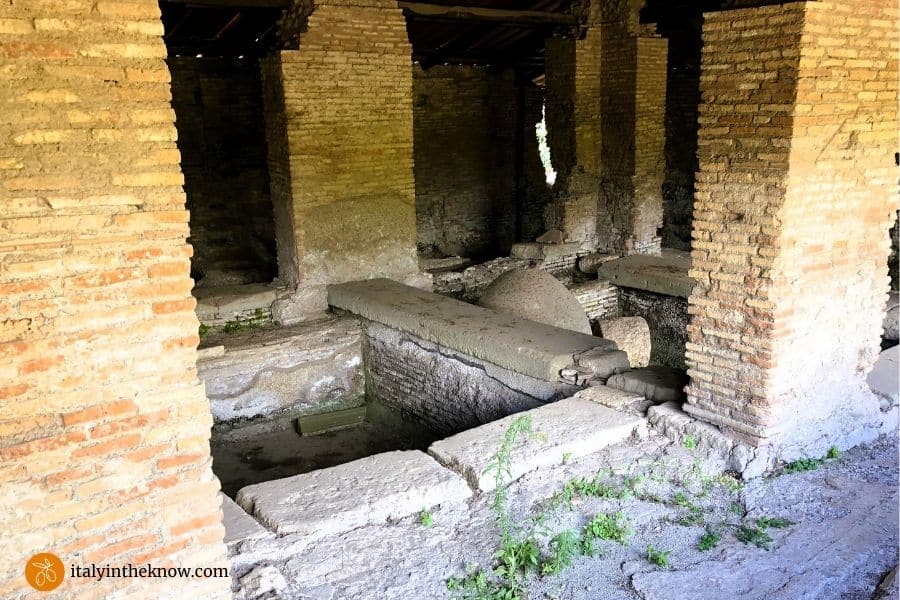
Laundries in ancient Rome were called fullonicas. They were shops for washing, processing, and dyeing fabric.
There were at least six in Ostia. A city with large numbers of travelers, merchants, and fabric transporters passing through meant a lot of dirty laundry.
Clothes were dipped into ammonia (get the audio guide for the backstory on the source). Then, fullers stood in containers and pressed the cloth with their feet to remove all the grease and dirt.
Horrea and Dolia
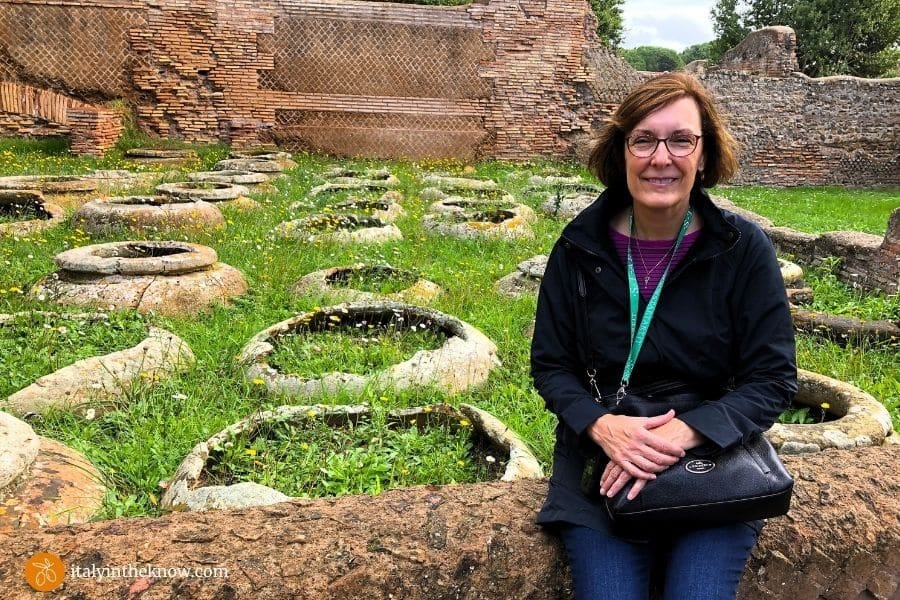
Goods came in from all over the Mediterranean and were transported by barges to Rome. Most critical was the wheat supply essential to feed Rome.
Because of this, Ostia is full of warehouses (horrea) used to store grain and other goods. In these you’ll see one of the main containers used at that time, a dolium.
Dolia (plural) were used to store and transport olive oil and wine. Each held about 275 gallons. They were often buried to keep contents cool.
Mill and Bakery
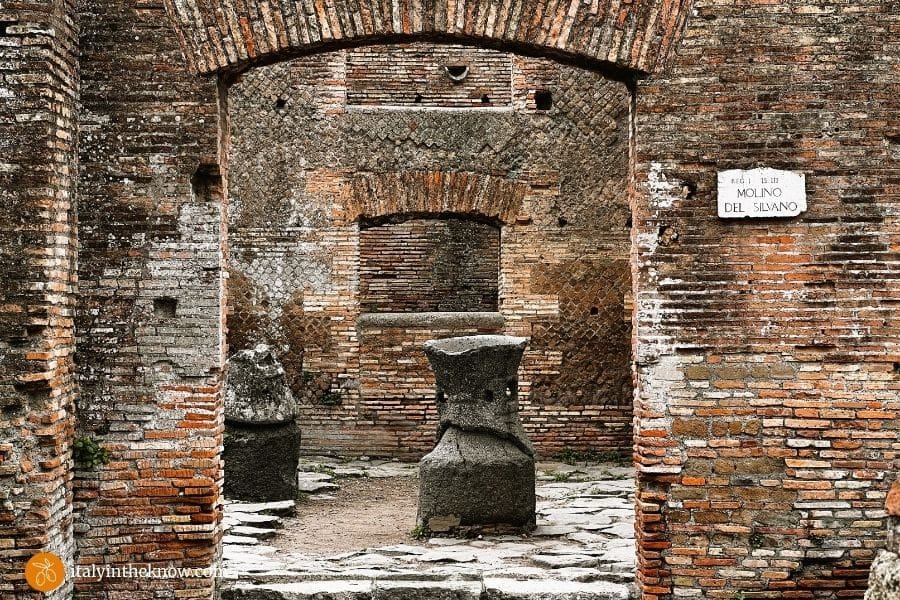
Ostia had several large bakeries. Each had specific areas inside to grind grain, knead flour, and bake and sell bread. Inside you’ll see the two-pieced millstones used to grind grain.
A cone shaped stationary base was topped by a moveable piece positioned on top of it. The top piece rotated using blindfolded mules which ground the grain. Blindfolds kept the mules from getting dizzy.
Housing
In ancient Roman cities, the front of houses and apartment complexes was usually right against the sidewalk or road. A central courtyard garden was typically found at the back or center.
As Ostia grew, space for housing in the central city was in short supply. In response, multi-story rental apartment complexes called insula were constructed.

These fell into two main categories. Apartments for the common people were usually just a couple of rooms.
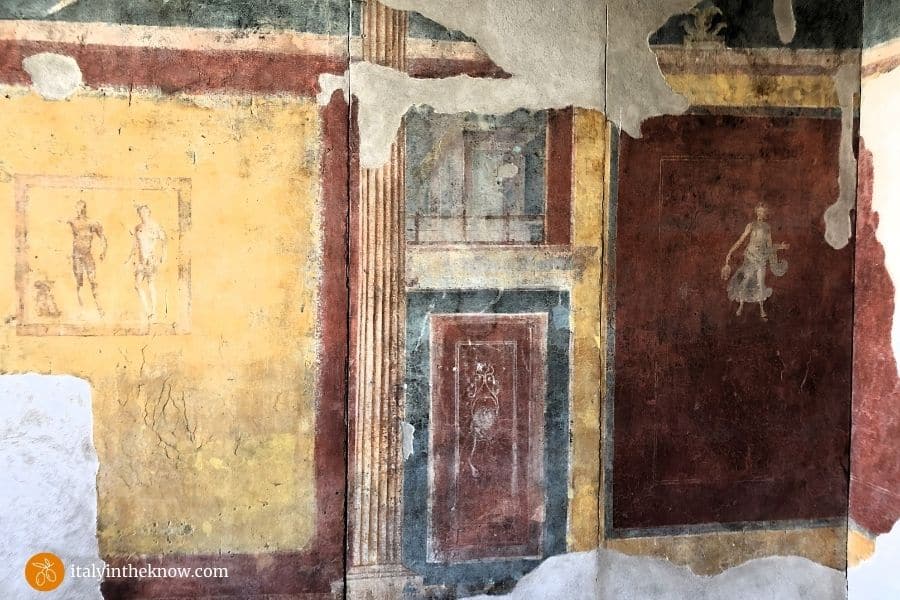
In contrast, the complexes for the well-to-do middle class often had beautiful wall frescos and mosaic floors.
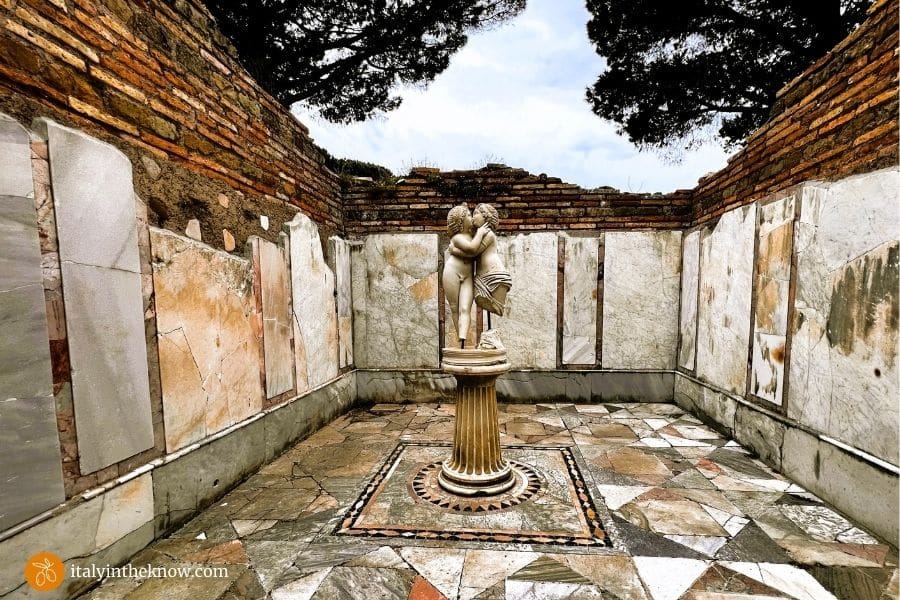
Aristocratic houses had lavish nymphaeum (water features), statues and precious polychrome marble details. These were 2-3 stories surrounding a large, porticoed courtyard in the center. The family lived on the first level and service staff lived above.
Shops
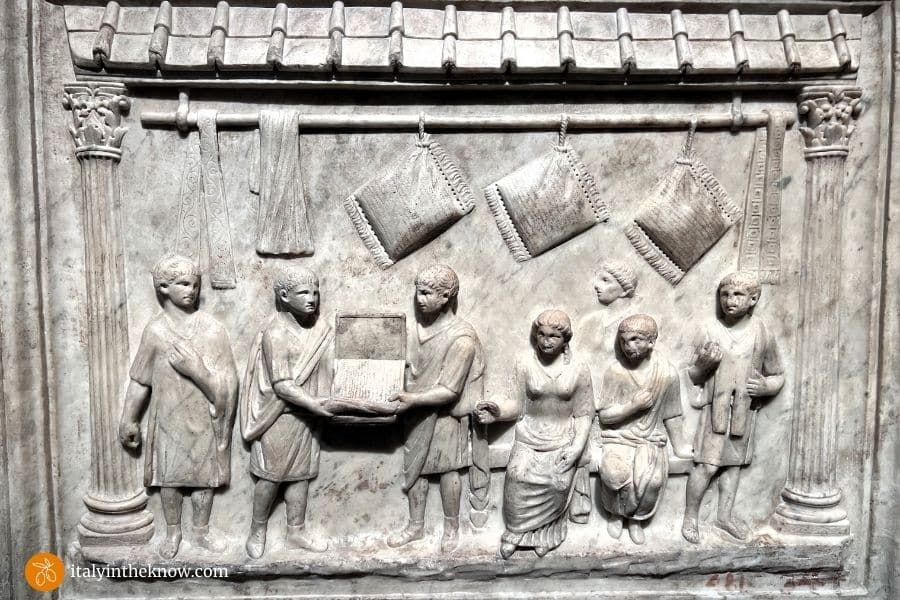
Shops in Ostia Antica were many and varied to supply its diverse population with goods and services. They were often found on the ground floor of insula (apartment complexes).
In many cases, shop owners lived in a small apartment above their shop that was accessible by an internal staircase.

One place to visit is the fishmonger’s shop with mosaics and an inscription against the evil eye: “inbide, tec alco”.
Places of Worship
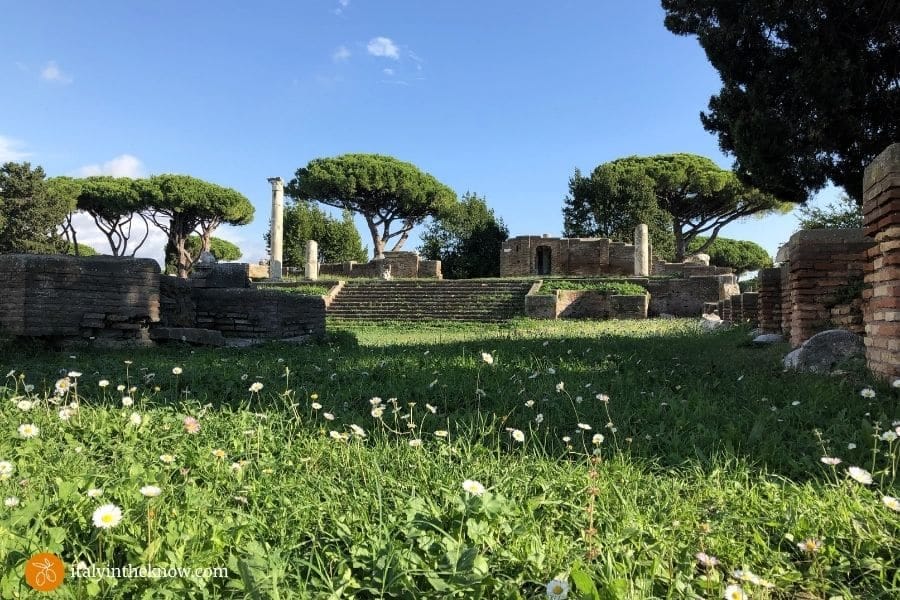
Ostia had a diverse population of people from throughout the Roman Empire. As such, it had temples and places of worship for numerous deities.
There are many structures to see including:
- Temples for Hercules and the Dioscuri of Castor and Pollux (considered the protectors of navigation)
- A Synagogue
- Several Christian Basilicas
- Mithraeums
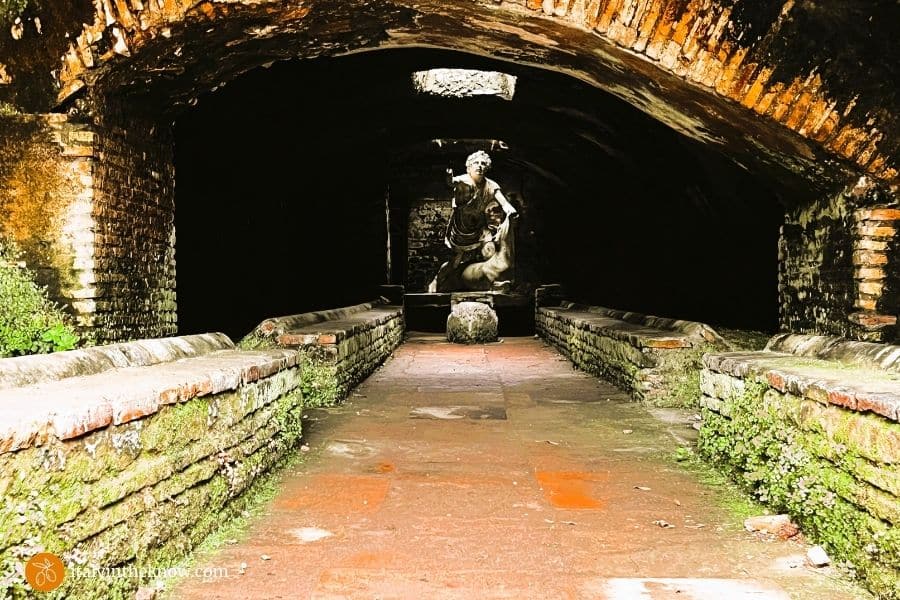
I recommend you include a Mithraeum on your list of sites to see. At one time, Ostia had 18 of these.
The cult of Mithras had Persian origins. Mithra was the sun god and represented victory of good over evil.
The cult was introduced by Roman soldiers returning from the East. It became popular and spread widely throughout the empire.
Mithraeums were underground or darkened rooms where cult members worshipped in secret. Worship halls were long and narrow. Inside, people sat or reclined on two long side benches.
While there, I recommend seeing the Mithraeum of Felicissimus and/or the Mithraeum of the Baths of Mithras.
Thermopolium
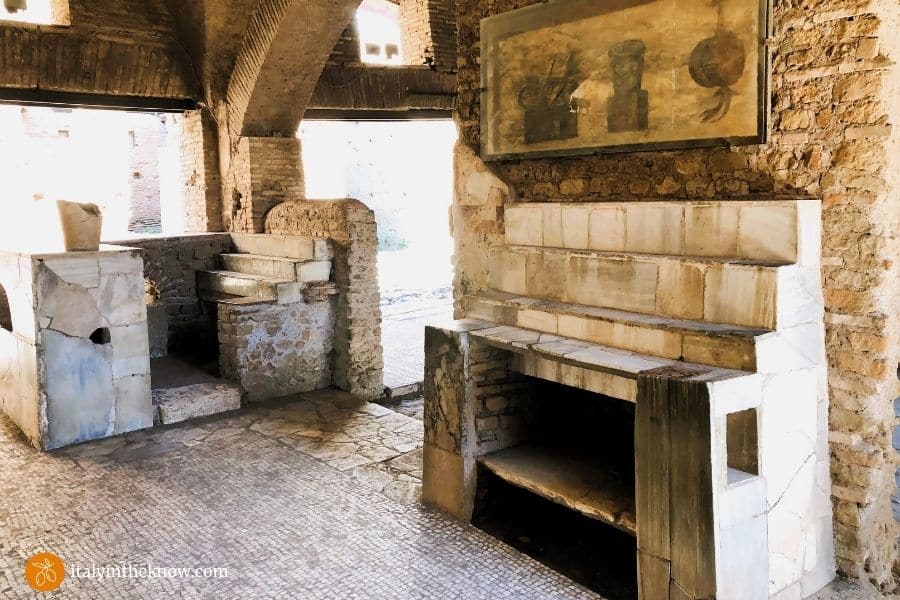
Many apartments were one or two rooms with limited cooking facilities. So, unless they were wealthy, most Romans ate at taverns and restaurants.
These local bars or shops were called popinas and sold hot food and beverages. The location at Ostia known as the thermopolium is a popina.
At the thermopolium you’ll see a counter that displayed food and drinks for sale, a marble tub for washing dishes, and a painting of what was on the menu. In the side room, there’s also the ancient version of a refrigerator.
Museum
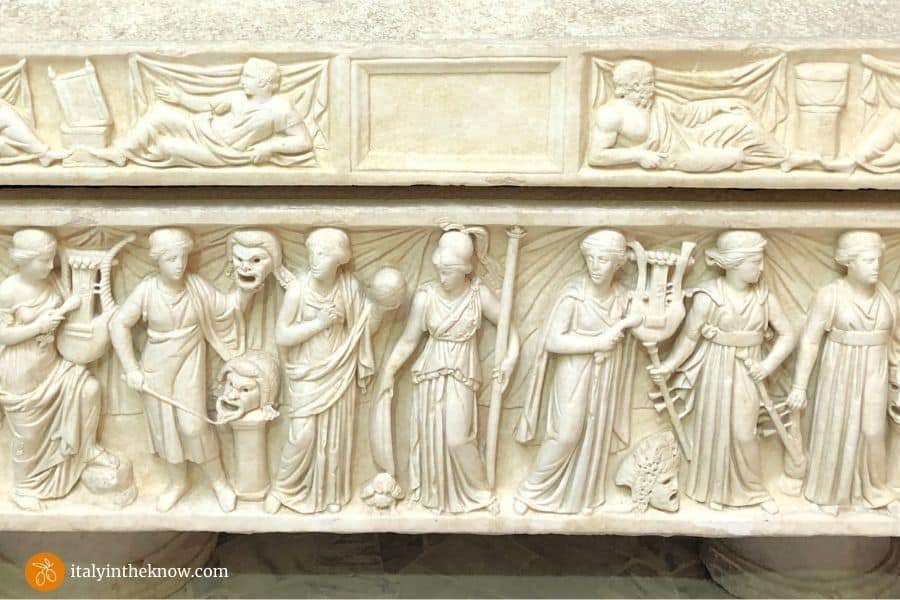
Make sure to visit the museum to see the many sculptures and other works uncovered during excavations. The various rooms focus on daily life, activities, and cults within the city. This gives you more insight into what life was like in ancient times.
Other Sites to See in Ostia Antica
The Medieval Borgo (Village) of Ostia Antica
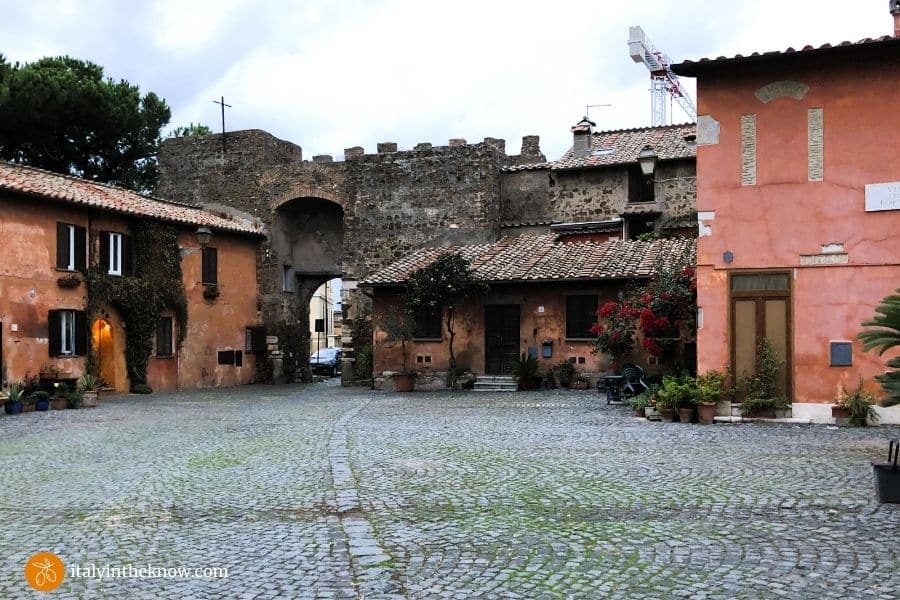
Even if you aren’t staying there, take time to wander through the walled medieval village of Ostia Antica.
The village was built by Pope Gregory IV in the 9th century to protect those in the area from Saracen raids. Its original name was Gregoriopoli after its benefactor, the Pope.
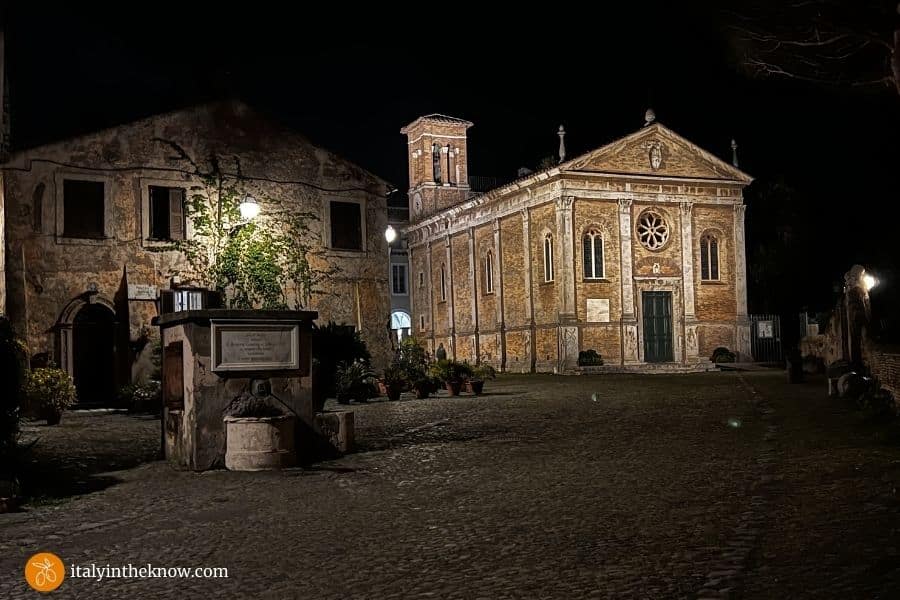
In the village is the Basilica of Saint Aurea, completed in 1483. It was built on an earlier 5th century church that was the site of Saint Aurea’s tomb.
The church’s namesake, Saint Aurea, is a young woman who was martyred in the area. She is the patron saint of Ostia.
Castle of Julius II
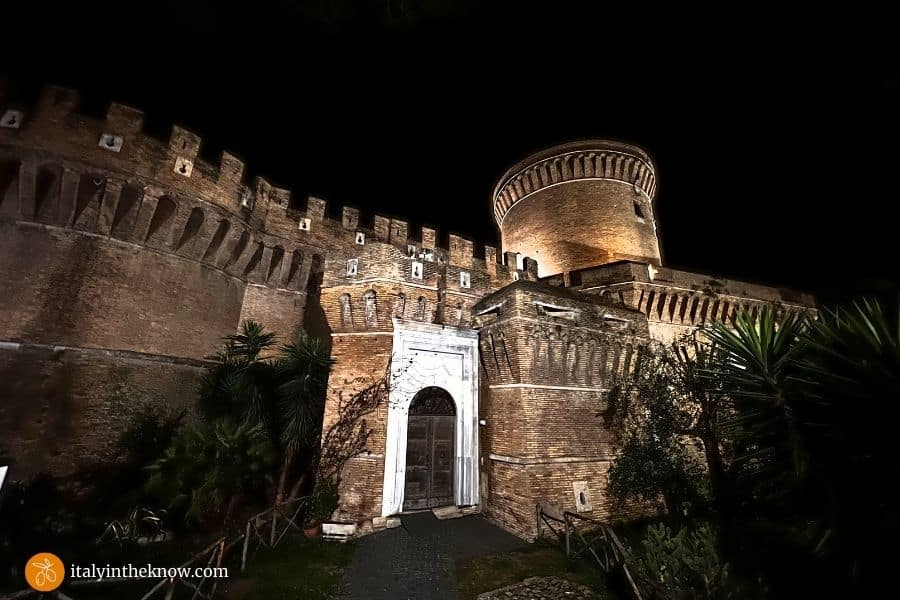
The castle is a fun and imposing presence in Ostia Antica and worth a visit if you have time. It began in the 15th century as a mere round tower with a moat. At that time, Pope Martin V built the tower to control river traffic on the Tiber.
In the 1480s, Cardinal Giuliano della Rovere (future Pope Julius II), financed the construction the castle you see today. It incorporates the original tower and is a great example of a military Renaissance castle.
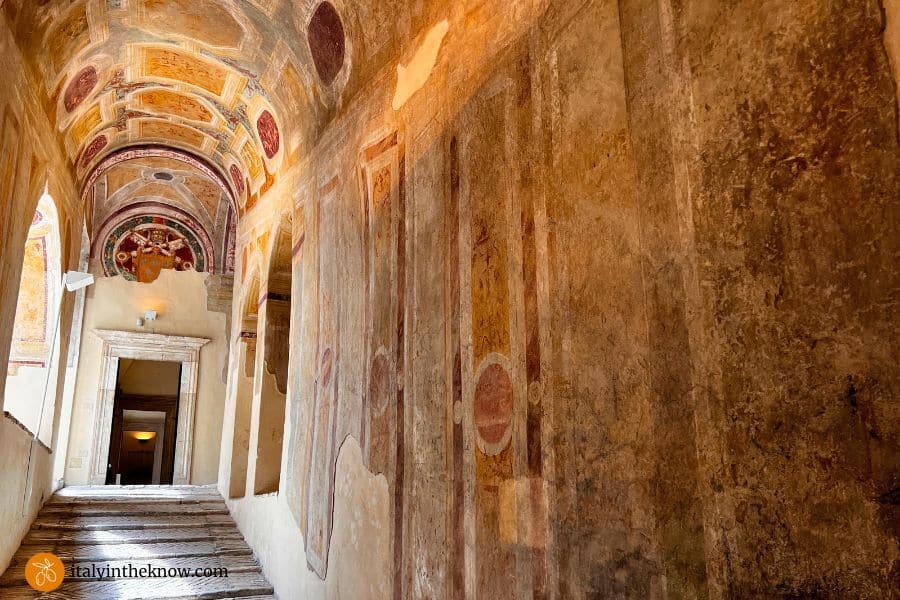
You’ll see firing chambers, cannon-proof rooms, a rivellino, a moat, and other defenses. There is also a huge staircase with Renaissance frescoes covering the walls.
Climbing to the top, you’ll have an extraordinary panoramic view of the surrounding area. Check the official website for opening days and hours.
Getting There
There are two main ways to get to Ostia Antica – by metro/train and hired car.
Metro/Train
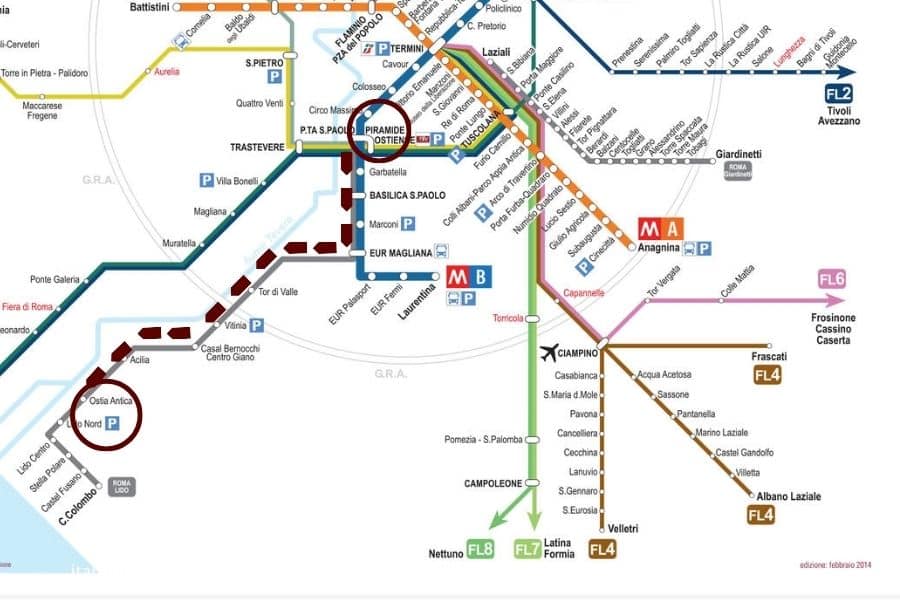
Starting in Rome, take the Metro line B to the Piramide stop. This connects to the Roma Porta San Paolo train station. When you get off the Metro train at Piramide, follow the signs to Lido (the beach). Board the next train as all stop at Ostia Antica on the way.
Your Metro ticket is good for the entire journey. Make sure to have it ready in case they want to see it on the train.
Once you get to Piramide station it will take about 30 minutes to arrive at Ostia Antica. From there, it is about a 5 minute walk to the archeological area and/or the castle and village.
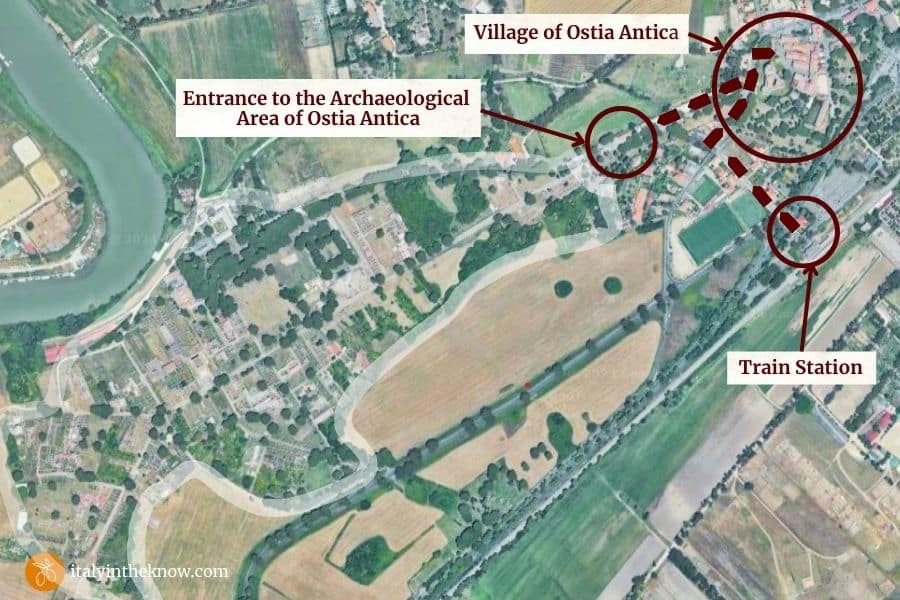
At the station, walk over the sky bridge above the road. Then take the first right. As you walk, you’ll see the entrance to the archeological area on the left. If you are staying in the village, keep going and it will be on the right just beyond the castle.
Hired car
There are many options here. If you are staying at an Airbnb (see “Where to Stay” below), contact your host and ask if they can arrange for a driver. Freenow, a popular “Uber like” app in Rome, is easy to use too.
Leaving
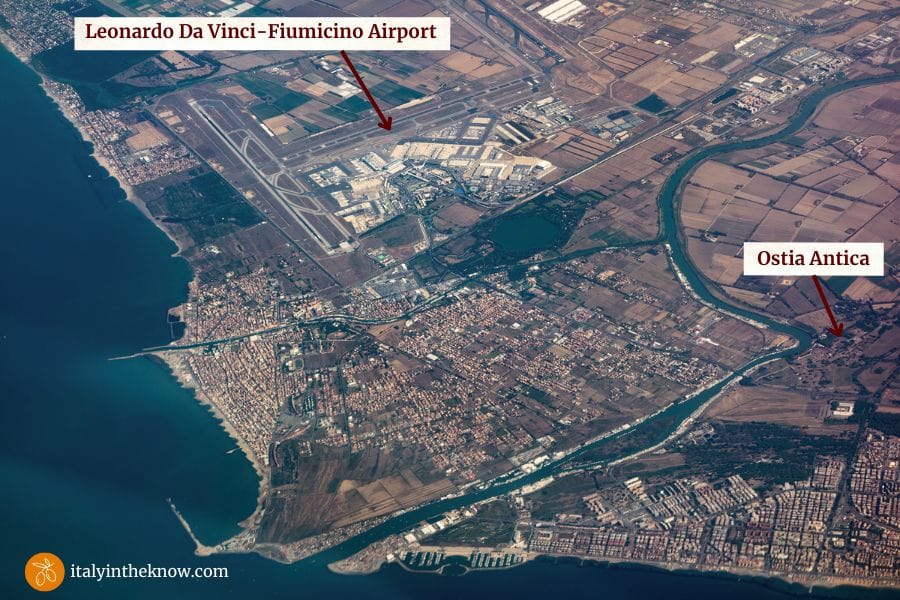
Finishing your Italy trip at Ostia Antica gives you a great benefit if you’re flying out of Rome. The town is only about 5 miles away from Fiumicino Airport. This is a drive that usually takes about 15 minutes.
My hosts have always coordinated a driver for me. They know the area and traffic patterns. Also, they are great at letting you know the time you need to leave.
Having said that, you do have other options. One is to use an app like Freenow.
Another is the bus which double or triples your time but is more economical. Since bus schedules change, check here for current options.
Where to Stay
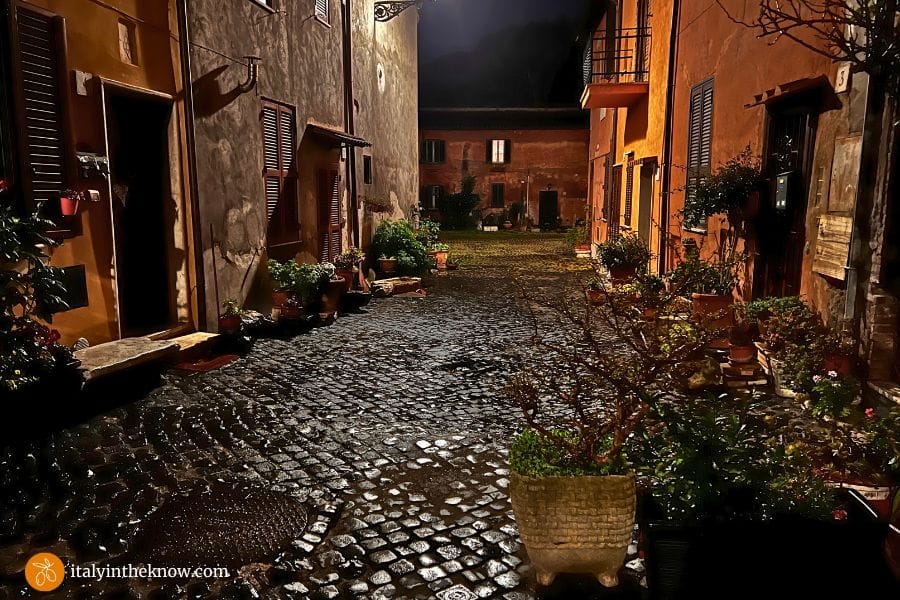
There are many options in the area. However, I really like to stay in the medieval village because of the ambience and convenience of walking everywhere.
- A favorite Airbnb of mine and an Airbnb Guest Favorite is Al Civico 7
Other places in the village that I have NOT stayed at but are highly rated are:
If you have a tight travel budget, you can rent a room at B&B “La Nave”. It is farther away from the archaeological area but still walkable. Paola is a kind and experienced Airbnb host.
Where to Eat
Below are two restaurants in the historic area that I recommend. Because you’re outside of Rome, make sure to check the days and hours each is open.
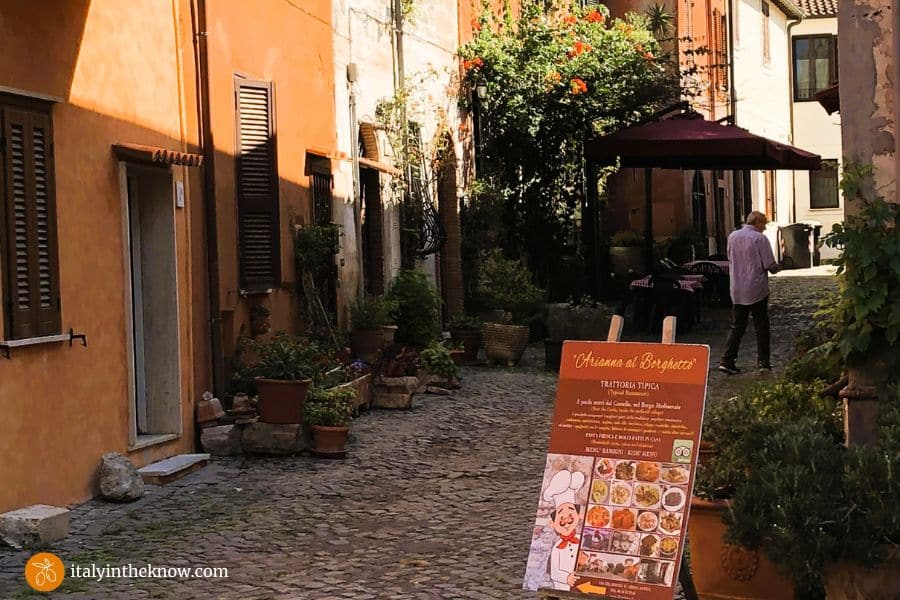
Arianna al Borghetto: Right in the medieval village, it has wonderful Roman cuisine and an old-world atmosphere. Antonio and his team are there to welcome you and provide excellent service. Not sure what to order? Ask for their recommendations and you’ll never go wrong. If the weather cooperates, enjoy dining al fresco.
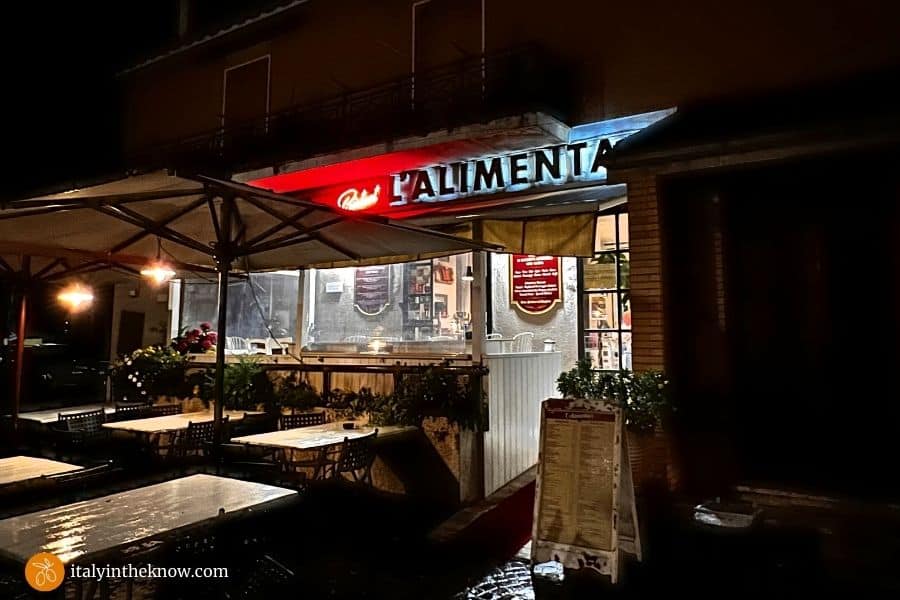
L’Alimentari: Right around the corner from the medieval village it is casual with great food. They also have various goods for sale. If you want to try something unique and refreshing, I recommend the interesting and delicious fennel and orange salad.
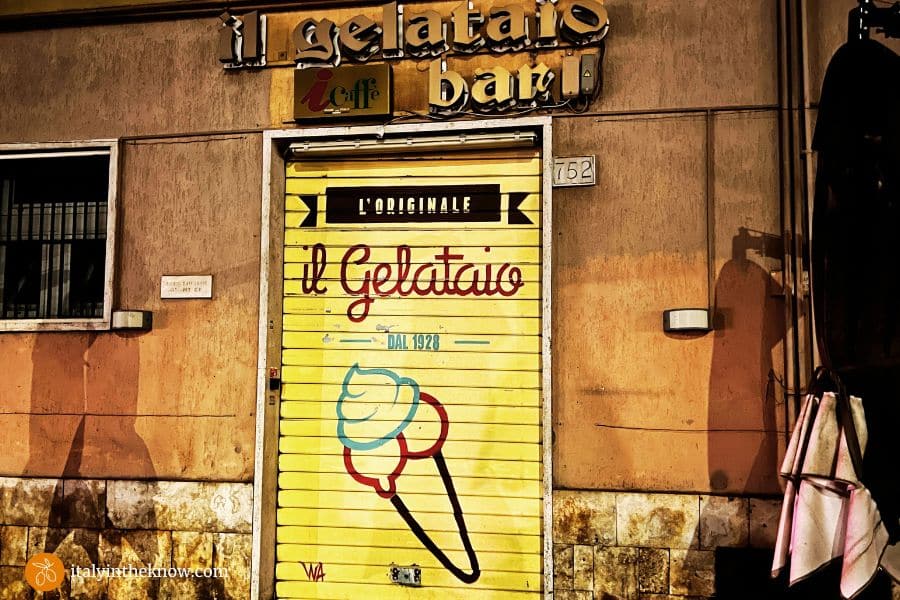
Need a gelato break? Check out family-run Il Gelataio around the corner from L’Alimentari.
Click to explore italyintheknow on Pinterest. Discover more insights, exciting destinations, and tips for an unforgettable journey. Prepare for a fantastic trip with italyintheknow as your guide!

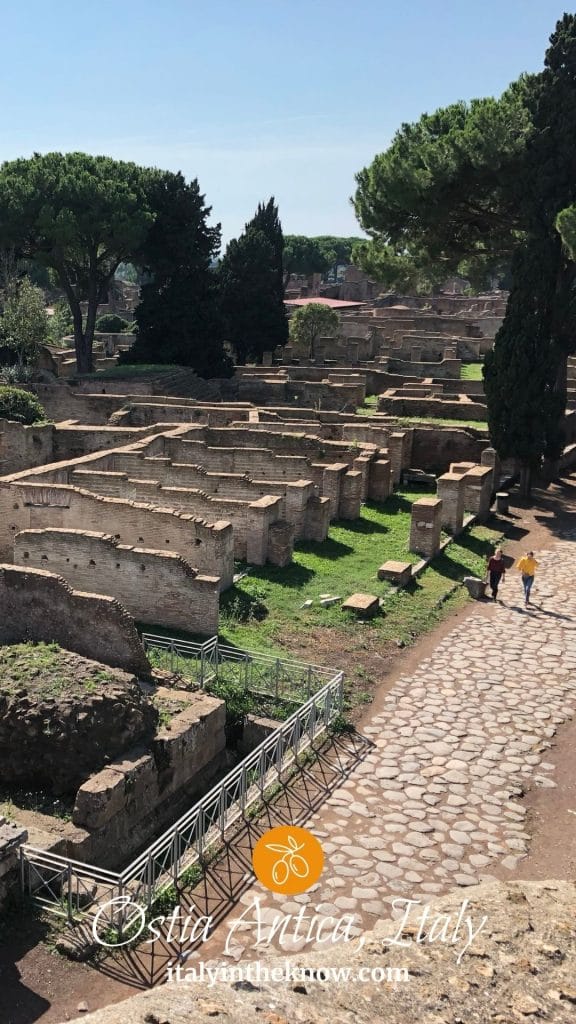
Thanks for sharing such useful information! I’ve been searching for insights on this topic, and your post is by far the best I’ve found. Looking forward to seeing more from you.